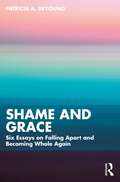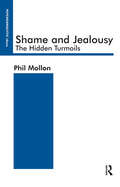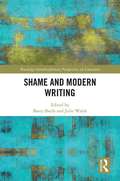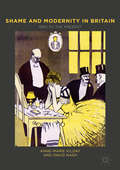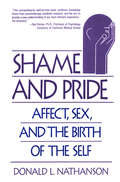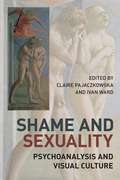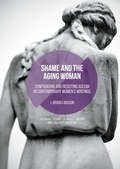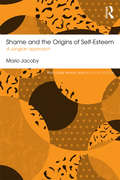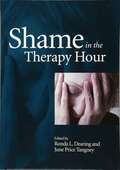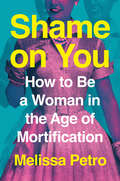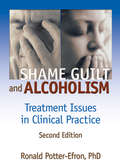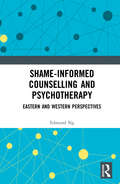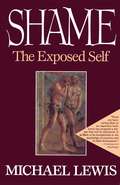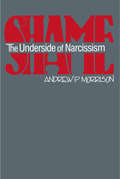- Table View
- List View
Shame and Grace: Healing the Shame We Don't Deserve
by Lewis B. SmedesA Proven Path to Move from Shame to Healing. If you persistently feel you don't measure up, you are feeling shame--that vague, undefined heaviness that presses on our spirit, dampens our gratitude for the goodness of life, and diminishes our joy. The good news is that shame can be healed. With warmth and wit, Lewis B. Smedes examines why and how we feel shame, and presents a profound, spiritual plan for healing. Step by step, Smedes outlines the road to well-being and the peace that comes from knowing we are accepted by the grace of One whose acceptance of us matters most.
Shame and Grace: Six Essays on Falling Apart and Becoming Whole Again
by Patricia A. DeYoungShame silences our stories, crushes our spirits, and cuts us off from our hearts. How can we give voice to what has happened? Could we fall apart into suffering that would heal us? Might we honour desires we’ve disowned for a lifetime? How do we gather up our battered parts of self with tenderness? Could grief and love restore our hearts to us?Having written groundbreaking theory about the developmental genesis of chronic shame and its treatment in relational psychotherapy, Patricia DeYoung returns to speak from her heart about what it’s like to inhabit a life of shame. In six essays, she writes of the essential impasses of chronic shame: silence, dissociation, isolation, the abolition of desire, the imposition of right and wrong, and ending life without meaning. Each impasse deserves a story.DeYoung’s stories of an ordinary life start with getting born and end with getting old. They open up crucial questions: Does the shame we suffer mean we’re as worthless as we feel, marking miles on a hard road to despair? Or does the longing beneath our shame mean we may hope for true connection and a chance at grace? Her essays privilege our longing and the difficult but powerful grace of being real and being-with. In this book, shame theory meets memoir and meditation. Therapists, patients, and self-reflective readers from many walks of life will be moved and changed by time spent with this master clinician, thoughtful mentor, and fellow traveler.
Shame and Humiliation: A Dialogue between Psychoanalytic and Systemic Approaches (The International Psychoanalytical Association Psychoanalytic Ideas and Applications Series)
by Carlos Guillermo BiglianiThis book is organised in a way of listening to a dialogue between theoretical approaches. It represents an effort to build bridges between the different ways, both psychoanalytical and systemic, of thinking about the shame and humiliation and its context, which can cross-fertilise each other.
Shame and Jealousy: The Hidden Turmoils (The\psychoanalytic Ideas Ser.)
by Phil MollonA volume in the Psychoanalytic Ideas Series, published for the Institute of Psychoanalysis by Karnac. Here, shame and jealousy are examined as hidden turmoils; as basic human feelings found in everyone but often suppressed and neglected. An unfulfilled need, unanswered plea for help, and failure to connect with and understand other people are all underlying causes for shame and feeling inadequate. The author argues that feelings of shame form an intrinsic part of the analytic encounter but 'astonishingly, this shame-laden quality of the psychoanalytic and psychotherapeutic setting is rarely addressed. This lucidly written and much-needed volume explores the profound effects shame and jealousy can have on self-esteem and how this can eventually lead to a chronic condition.
Shame and Modern Writing (Routledge Interdisciplinary Perspectives on Literature)
by Julie Walsh Barry SheilsShame and Modern Writing seeks to uncover the presence of shame in and across a vast array of modern writing modalities. This interdisciplinary volume includes essays from distinguished and emergent scholars in the Humanities and Social Sciences, and shorter practice-based reflections from poets and clinical writers. It serves as a timely reflection of shame as presented in modern writing, giving added attention to engagements on race, gender, and the question of new media representation.
Shame and Modernity in Britain
by Anne-Marie Kilday David S. NashThis book argues that traditional images and practices associated with shame did not recede with the coming of modern Britain. Following the authors' acclaimed and successful nineteenth century book, Cultures of Shame, this new monograph moves forward to look at shame in the modern era. As such, it investigates how social and cultural expectations in both war and peace, changing attitudes to sexual identities and sexual behaviour, new innovations in media and changing representations of reputation, all became sites for shame's reconstruction, making it thoroughly modern and in tune with twentieth century Britain's expectations. Using a suite of detailed micro-histories, the book examines a wide expanse of twentieth century sites of shame including conceptions of cowardice/conscientious objection during the First World War, fraud and clerical scandal in the interwar years, the shame associated with both abortion and sexual behaviour redefined in different ways as 'deviant', shoplifting in the 1980s and lastly, how homosexuality shifted from 'Coming Out' to embracing 'Pride', finally rediscovering the positivity of shame with the birth of the 'Queer'.
Shame and Pride: Affect, Sex, and the Birth of the Self
by Donald L. NathansonThis is a revolutionary book about the nature of emotion, about the way emotions are triggered in our private moments, in our relations with others, and by our biology. Drawing on every theme of the modern life sciences, Donald Nathanson shows how nine basic affects--interest-excitement, enjoyment-joy, surprise-startle, fear-terror, distress-anguish, anger-rage, dissmell, disgust, and shame-humiliation--not only determine how we feel but shape our very sense of self. For too long those who explain emotional discomfort on the basis of lived experience and those who blame chemistry have been at loggerheads. As Dr. Nathanson shows, chemicals and illnesses can affect our mood just as surely as an uncomfortable memory or a stern rebuke. Linking for the first time the affect theory of the pioneering researcher Silvan S. Thomkins with the entire world of biology, medicine, psychology, psychotherapy, religion, and the social sciences, Dr. Nathanson presents a completely new understanding of all emotion.
Shame and Sexuality: Psychoanalysis and Visual Culture
by Ivan Ward Claire PajaczkowskaWhy do human beings feel shame? What is the cultural dimension of shame and sexuality? Can theory understand the power of affect? How is psychoanalysis integral to cultural theory? The experience of shame is a profound, painful and universal emotion with lasting effects on many aspects of public life and human culture. Rooted in childhood experience, linked to sexuality and the cultural norms which regulate the body and its pleasures, shame is uniquely human. Shame and Sexuality explores elements of shame in human psychology and the cultures of art, film, photography and textiles. This volume is divided into two distinct sections allowing the reader to compare and contrast the psychoanalytic and the cultural writings. Part I, Psychoanalysis, provides a psychoanalytic approach to shame, using clinical examples to explore the function of unconscious fantasies, the shame shield in child sexual abuse, and the puzzling manner in which shame attaches itself to sexuality. Part II, Visual Culture, is illustrated throughout with textual analysis; contributors explore shame and sexuality in art history, politics and contemporary visual culture, including the gendering of shame, shame and abjection, and the relationship between shame and shamelessness as a strategy of resistance. Claire Pajaczkowska and Ivan Ward bring together debates within and between the discourses of psychoanalysis and visual culture, generating new avenues of enquiry for scholars of culture, theory and psychoanalysis.
Shame and the Aging Woman
by J. Brooks BousonThis book brings together the research findings of contemporary feminist age studies scholars, shame theorists, and feminist gerontologists in order to unfurl the affective dynamics of gendered ageism. In her analysis of what she calls "embodied shame," J. Brooks Bouson describes older women's shame about the visible signs of aging and the health and appearance of their bodies as they undergo the normal processes of bodily aging. Examining both fictional and nonfiction works by contemporary North American and British women authors, this book offers a sustained analysis of the various ways that ageism devalues and damages the identities of otherwise psychologically healthy women in our graying culture. Shame theory, as Bouson shows, astutely explains why gendered ageism is so deeply entrenched in our culture and why even aging feminists may succumb to this distressing, but sometimes hidden, cultural affliction.
Shame and the Making of Art: A Depth Psychological Perspective (Research in Analytical Psychology and Jungian Studies)
by Deborah CluffShame remains at the core of much psychological distress and can eventuate as physical symptoms, yet experiential approaches to healing shame are sparse. Links between shame and art making have been felt, intuited, and examined, but have not been sufficiently documented by depth psychologists. Shame and the Making of Art addresses this lacuna by surveying depth psychological conceptions of shame, art, and the role of creativity in healing, contemporary and historical shame ideologies, as well as recent psychobiological studies on shame. Drawing on research conducted with participants in three different countries, the book includes candid discussions of shame experiences. These experiences are accompanied by Cluff’s heuristic inquiry into shame with an interpretative phenomenological analysis that focuses on how participants negotiate the relationship between shame and the making of art. Cluff’s movement through archetypal dimensions, especially Dionysian, is developed and discussed throughout the book. The results of the research are further explicated in terms of comparative studies, wherein the psychological processes and impacts observed by other researchers and effects on self-conscious maladaptive emotions are described. Shame and the Making of Art should be essential reading for academics, researchers, and postgraduate students engaged in the study of psychology and the arts. It will be of particular interest to psychologists, Jungian psychotherapists, psychiatrists, social workers, creativity researchers, and anyone interested in understanding the dynamics of this shame and self-expression.
Shame and the Origins of Self-Esteem: A Jungian approach (Routledge Mental Health Classic Editions)
by Mario JacobyShame is one of our most central feelings and a universal human characteristic. Why do we experience it? For what purpose? How can we cope with excessive feelings of shame? In this elegant exposition informed by many years of helping people to understand feelings of shame, leading Jungian analyst Mario Jacoby provided a comprehensive exploration of the many aspects of shame and showed how it occupies a central place in our emotional experience. Jacoby demonstrated that a lack of self-esteem is often at the root of excessive shame, and as well as providing practical examples of how therapy can help, he drew upon a wealth of historical and cultural scholarship to show how important shame is for us in both its individual and social aspects. This Classic Edition includes a new foreword by Marco Della Chiesa.
Shame and the Origins of Self-Esteem: A Jungian approach (Routledge Mental Health Classic Editions)
by Mario JacobyShame is one of our most central feelings and a universal human characteristic. Why do we experience it? For what purpose? How can we cope with excessive feelings of shame?In this elegant exposition informed by many years of helping people to understand feelings of shame, leading Jungian analyst Mario Jacoby provided a comprehensive exploration of the many aspects of shame and showed how it occupies a central place in our emotional experience. Jacoby demonstrated that a lack of self-esteem is often at the root of excessive shame, and as well as providing practical examples of how therapy can help, he drew upon a wealth of historical and cultural scholarship to show how important shame is for us in both its individual and social aspects. This Classic Edition includes a new foreword by Marco Della Chiesa.
Shame in Context
by Susan MillerIn this enlightening and gracefully written study, Susan Miller examines shame in a variety of clinical contexts en route to a richer understanding of shame dynamics. Miller attends especially to the role of shame in creating and maintaining character pathology and devotes separate sections of the book to shame in the context of obsessive-compulsive, narcissistic, and masochistic personality organizations. Within each of these clinical contexts, a chapter of theoretical discussion is followed by a chapter of engaging case examples. Integral to Shame in Context is Miller's informed and thoughtful critique of current theories about shame, including those of Broucek, Morrison, Schore, Wurmser, Nathanson, and Kinston. In reviewing the contributions of these and other writers, she is most concerned with achieving a balanced comprehension of shame that incorporates the insights of different theoretical perspectives without embracing the selective emphases of any one investigator or school of thought. Like Freud, she appreciates the defensive utility of shame, but she attends equally to the painful and at times pathogenic acpects of shame experiences. In line with more recent shame literature, she emphasizes the pathogenicity of early shaming, but she is equally sensitive to the role of shame in sustaining character defenses. And she goes beyond the purview of other shame researchers in examining the ways in which individuals unconsciously seek to maintain shame experiences when these experiences sustain their personality organizations. Offering a critical evaluation and synthesis of contemporary shame theories, and culminating in a balanced clinical understanding of shame in its various contexts, Shame in Context takes its place as, in the words of Frances Broucek, "the most sophisticated and definitive clinical study of shame to date."
Shame in the Therapy Hour
by June Tangney Ronda DearingShame is prevalent among individuals undergoing psychotherapy. Yet, there is limited guidance for clinicians trying to help their clients deal with shame-related concerns. This book explores the manifestations of shame and presents several approaches for treatment. Master clinicians from a wide variety of different theoretical and practice orientations offer candid insights into all aspects of shame, including how it develops, how it relates to psychological difficulties, how to recognize it, and how to help clients resolve it. Strategies for dealing with therapist shame are also provided, since the therapist’s own shame can be triggered during sessions and may complicate the therapeutic process. Detailed case studies are included.
Shame on You: How to Be a Woman in the Age of Mortification
by Melissa PetroIn the spirit of Rebecca Traister's Good and Mad and Roxane Gay's Bad Feminist comes a courageous, in-depth investigation into the modern epidemic of shame in our society—what it is, why women are uniquely susceptible, and how we can shift the shame off our plates and live our best lives in an over-exposed, image-obsessed world.For millions of women, shame is a vicious predator. It tells us we are less than, that we are unworthy. We try everything to escape shame—ignoring it, intellectualizing it, and even, ironically, shaming ourselves for feeling it. The reality is that women experience shame more frequently and more intensely than men—a direct result, as acclaimed journalist Melissa Petro explains, of a patriarchal culture that &“urges women to feel bad about themselves, and then punishes them when they do.&” Why can&’t we figure out how to break the shame cycle once and for all?In Shame on You, Petro takes on the issue of women&’s shame directly with an unflinching look at the social systems that encourage women to believe we are deeply inadequate. From shame&’s beginnings ( Maybe she&’s born with it? Nope, it&’s misogyny.) to its effect on our lives as adults (How the humiliation of &“bad women&” affects us all.), shame poisons our friendships, romantic relationships, and work lives. But it doesn&’t have to be that way. Blending investigative reporting, science, literature, and hundreds of women&’s personal stories—including her own shameful account of winding up as an unwitting New York Post cover girl—Petro offers us a new way forward. No matter what you do, she explains, there is no escaping being judged. And yet, the women we can become—sometimes as a consequence of shame, rather than in spite of it—are powerful indeed. And maybe that&’s what others are afraid of.
Shame, Guilt, and Alcoholism: Treatment Issues in Clinical Practice (Addiction Treatment Ser. #Vol. 2)
by Ron Potter-Efron Bruce CarruthIncrease your understanding of the link between alcoholism and shame and guilt with this tremendously important book that adds to our understanding of the total recovery process. This practical volume authoritatively defines the often elusive terms of shame and guilt and provides constructive suggestions to therapists for treating alcoholic clients and affected family members who are suffering from excessive quantities of shame and guilt. Shame, Guilt, and Alcoholism thoroughly explains to therapists the significant differences between shame and guilt as displayed by clients’experiences of failure, primary responses and feelings, precipitating events and involvement of self, and origins and central fears. Author Potter-Efron includes creative approaches to the general treatment of shame and guilt, explores the positive functions of shame and guilt, describes the conscious and subconscious defense mechanisms against shame and guilt, and highlights the very crucial family behaviors that initiate and encourage shame and guilt. Shame, Guilt, and Alcoholism adds immeasurably to our understanding of the total recovery process.
Shame, Guilt, and Alcoholism: Treatment Issues in Clinical Practice, Second Edition (Addiction Treatment Ser. #Vol. 2)
by Ron Potter-Efron Bruce CarruthExplore the causes and effects of the shame/guilt/addiction cycle!Since the original edition in 1989, great strides have been made in understanding the overlapping functions of shame and guilt and the ways these painful emotions are linked with addictions. Shame, Guilt, and Alcoholism: Treatment Issues in Clinical Practice, Second Edition, integrates up-to-date psychological research with penetrating insight into the emotional realities of substance abuse. It provides a clear and practical model for understanding the shame/guilt/addiction cycle.Shame, Guilt, and Alcoholism provides constructive suggestions to therapists for treating substance-abusing clients and their affected family members. By treating destructive, inappropriate, or excessive shame and guilt, therapists can help their clients free themselves from the downward spiral of addiction and begin to build on their genuine strengths. It explores the positive functions of shame and guilt, describes the conscious and subconscious defense mechanisms against them, and highlights the crucial family behaviors that initiate and encourage shame and guilt. Shame, Guilt, and Alcoholism thoroughly explains the significant differences between shame and guilt, including: clients’experiences of failure primary responses and feelings precipitating events and involvement of self origins and central fearsShame, Guilt, and Alcoholism adds immeasurably to our understanding of the total recovery process. It is an essential resource for therapists, social workers, psychologists, substance-abuse counselors, and educators in the field.
Shame, Pride, and Relational Trauma: Concepts and Psychotherapy
by Ken BenauShame, Pride, and Relational Trauma is a guide to recognizing the many ways shame and pride lie at the heart of psychotherapy with survivors of relational trauma. In these pages, readers learn how to differentiate shame and pride as emotional processes and traumatic mind/body states. They will also discover how understanding the psychodynamic and phenomenological relationships between shame, pride, and dissociation benefit psychotherapy with relational trauma. Therapists will learn about ways to conceptualize and successfully navigate complex, patient-therapist shame dynamics, and apply neuroscientific findings to this challenging work. Finally, readers will discover how the concept and phenomena of pro-being pride, that is delighting in one's own and others' unique aliveness, helps patients transcend maladaptive shame and pride and experience greater unity within, with others, and with the world beyond.
Shame, Temporality and Social Change: Ominous Transitions (Philosophy and Psychoanalysis)
by Ladson Hinton Hessel WillemsenThere is a broad consensus that we are in a time of profound transition. There is worldwide political and social turbulence, with an underlying loss of hope and confidence about the future. Technological change and the stresses of late-stage capitalism, along with climate change, undermine social trust and hope for a future worth living. Shameless behavior is rampant, undermining respect for habits and institutions that hold societies together. Shame, Temporality and Social Change offers multi-disciplinary insight into these concerns. Hinton and Willemsen’s collection covers themes including racism, cultural norms, memory and vulnerability, with examinations of shame at its core. It explores the meaning and significance of shame in a world of social media, autocratic leaders and algorithms and what we can learn from myth as we progress. Increased awareness of the inter-connection of shame and temporality with the ominous transitions of our times provides thought-provoking insights for theory and practice and the ethical decisions of everyday life. Psychoanalysts, psychotherapists, philosophers, anthropologists and academics and students engaged in cultural studies and critical theory will gain valuable insights from this book’s rich and engaging variety of perspectives on our times.
Shame-informed Counselling and Psychotherapy: Eastern and Western Perspectives
by Edmund NgUnhealthy or maladaptive shame is believed by many to be the root cause of a diverse range of mental health problems. If we want to offer a more reparative healing to people contending with these psychological issues, we must ultimately trace back and resolve their underlying shame. This book offers researchers practitioners and students a balance of theoretical and empirical evidence for a practical approach in shame-informed counselling and psychotherapy approach. Drawing on empirical field study evidence on shame, and making references to both Western and Eastern literature on the subject, Ng advocates that shame-informed interventions be applied following or alongside the contemporary counselling modalities and protocols. Using his 15 years’ professional practice in the field, he offers a shame-informed counselling and psychotherapy approach which aims not merely to help the individual cope with or suppress the shame as commonly advocated in current literature, but also deals with its roots through the restructuring of core beliefs and early memories.
Shame: Developmental, Cultural, and Clinical Realms
by Salman AkhtarA late-comer to psychoanalytic theorizing, 'shame' results from a disjunction between the ego and the ego-ideal. A complex psychosocial experience, it is comprised of a painful exposure of one's vulnerable aspects, rupture of self-continuity, and a sense of isolation. The figure-ground harmony of 'going-on-being' is disrupted and the individual feels alone and watched by others. Shame pushes for hiding and thus intensifies the experience of isolation. Seeking to advance clinicians' empathy and therapeutic skills in this realm, in this book ten distinguished analysts discuss shame from various perspectives. These include its developmental substrate, its vicissitudes during adolescence, and its manifestations in the course of aging and infirmity. The authors discuss shame from a cross-cultural viewpoint and note how shame-driven search for power and glory can turn malignant and societally destructive. They also address shamelessness, the link between shame and laziness, and the shame that underlies the inability to apologize.
Shame: The Exposed Self
by Michael LewisShame, the quintessential human emotion, received little attention during the years in which the central forces believed to be motivating us were identified as primitive instincts like sex and aggression. Now, redressing the balance, there is an explosion of interest in the self-conscious emotion. Much of our psychic lives involve the negotiation of shame, asserts Michael Lewis, internationally known developmental and clinical psychologist. Shame is normal, not pathological, though opposite reactions to shame underlie many conflicts among individuals and groups, and some styles of handling shame are clearly maladaptive. Illustrating his argument with examples from everyday life, Lewis draws on his own pathbreaking studies and the theory and research of many others to construct the first comprehensive and empirically based account of emotional development focused on shame. In this paperback edition, Michael Lewis adds a compelling new chapter on stigma in which he details the process in which stigmatization produces shame.
Shame: The Politics and Power of an Emotion
by David KeenThe uses of shame (and shamelessness) in spheres that range from social media and consumerism to polarized politics and mass violenceToday, we are caught in a shame spiral—a vortex of mutual shaming that pervades everything from politics to social media. We are shamed for our looks, our culture, our ethnicity, our sexuality, our poverty, our wrongdoings, our politics. But what is the point of all this shaming and countershaming? Does it work? And if so, for whom?In Shame, David Keen explores the function of modern shaming, paying particular attention to how shame is instrumentalized and weaponized. Keen points out that there is usually someone who offers an escape from shame—and that many of those who make this offer have been piling on shame in the first place. Self-interested manipulations of shame, Keen argues, are central to understanding phenomena as wide-ranging as consumerism, violent crime, populist politics, and even war and genocide. Shame is political as well as personal. To break out of our current cycle of shame and shaming, and to understand the harm that shame can do, we must recognize the ways that shame is being made to serve political and economic purposes.Keen also traces the rise of leaders on both sides of the Atlantic who possess a dangerous shamelessness, and he asks how shame and shamelessness can both be damaging. Answering this question means understanding the different types of shame. And it means understanding how shame and shamelessness interact—not least when shame is instrumentalized by those who are selling shamelessness. Keen points to a perverse and inequitable distribution of shame, with the victims of poverty and violence frequently being shamed, while those who benefit tend to exhibit shamelessness and even pride.
Shame: The Underside of Narcissism
by Andrew P. MorrisonMorrison provides a critical history of analytic and psychiatric attempts to make sense of shame, beginning with Freud and culminating in Kohut's understanding of shame in terms of narcissistic phenomena. The clinical section of the book clarifies both the theoretical status and treatment implications of shame in relation to narcissistic personality disorder, neurosis and higher-level character pathology, and manic-depressive illness.
Shandean Psychoanalysis: Tristram Shandy, Madness and Trauma
by Françoise DavoineThis unique book examines the psychoanalysis of madness and trauma through an extended discussion of The Life and Opinions of Tristram Shandy, Gentleman, the provocative eighteenth-century novel by Laurence Sterne. Françoise Davoine explores the entire novel—each of her chapters corresponding to a volume of the novel—viewing it through a psychoanalytic lens: the monologue by Tristram’s embryo in the opening chapter, the war traumas of Captain Toby and Corporal Trim and several key themes, including confinement, love and history. In parallel to her own analytic comments on these inventions, Françoise Davoine follows the writing of the novel itself, keeping the reader constantly aware that Sterne’s endeavour is a race against death—his own. Davoine points out that time acts as a major character in the novel, constantly upsetting chronology, and bringing about the same impasses as the psychoanalysis of madness and trauma does. The book presents Shandean wit as a valuable tool in therapeutic work. Shandean Psychoanalysis will be of great interest to psychoanalysts and to academics and students engaged in psychoanalytic studies, literary studies and trauma-related studies.

